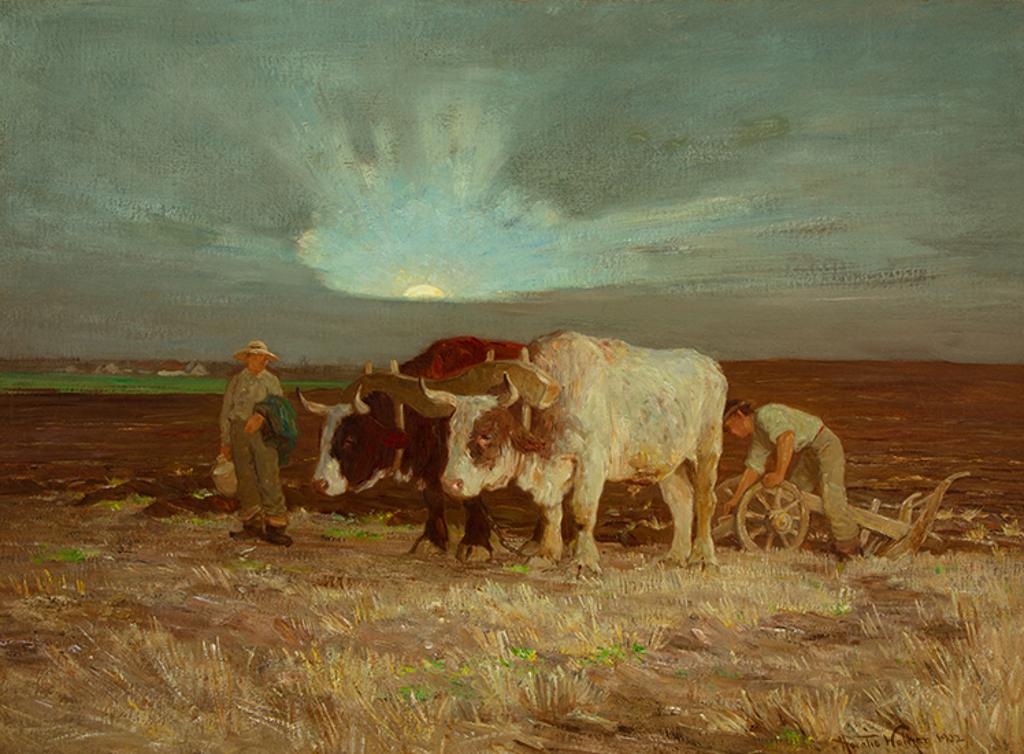
Moonrise, A Canadian Pastoral
71.8 cms x 96.5 cms (28.25 ins x 38 ins)
Signed and dated 1902 and on verso titled, dated on the gallery label, inscribed "b4582" on dominion gallery label and "cat no 51" on the art gallery of ontario label and stamped with the dominion gallery stamp
made in 1902
Lot offered for sale by Heffel, Vancouver at the auction event "November 2021 Online auction" held on Thu, Nov 25, 2021.
Lot 0240
Lot 0240
Estimate: CAD $40,000 - $60,000
Realised: CAD $43,250
Realised: CAD $43,250
Lot description - from the online catalogue*
Provenance:
Collection of Dr. Alexander C. Humphreys, Carnegie Institute, Pittsburgh
Dominion Gallery, Montreal
Peter Ohler Fine Arts Ltd., Vancouver
Private Collection, British Columbia
Exhibitions:
Royal Academy Stockholm, Exhibition of American Art for Sweden, March - April 1930, traveling in 1930 to the Glyptotek, Copenhagen; the Kunstverein, Munich; and the Brooklyn Museum
Art Gallery of Ontario, Horatio Walker, R.C.A., N.A. (1858 - 1938) Memorial Exhibition, traveling in 1941 to the National Gallery of Canada, Ottawa and the Art Association of Montreal
Art Gallery of Ontario, Collector's Canada, catalogue #51
Notes:
Canadian-born painter Horatio Walker is known for his depictions of rural Quebec, for which he achieved international acclaim in the early twentieth century. While Walker never received a formal art education, as a teenager he worked at a Toronto photographic firm, and studied under artists Robert Ford Gagen, John Fraser and Lucius O’Brien. In 1882 Walker traveled to Europe, and in the decades following lived throughout the northeastern United States. Given Walker’s international experience, he was well acquainted with the French Barbizon school, and was particularly influenced by Jean-Francois Millet’s depictions of French peasant farmers. Like Millet and the Barbizon, Walker sought to represent everyday rural subjects in a natural and dignified manner. Walker received numerous gold medals at exhibitions throughout the United States, and a bronze medal at the Paris World Exhibition (1889). He was a co-founder of the Arts Club of Canada in 1907, and succeeded his friend Homer Watson as its president in 1915.
In the first years of twentieth century – when Moonrise, A Canadian Pastoral, was painted – Walker was at the height of his professional success. Many of Walker’s major paintings were produced during this period, including Ploughing the First Gleam at Dawn (1900) and The Ice Cutters (1904), both in the Musée national des beaux-arts du Québec. Like Millet’s nocturnal renderings, Moonrise, A Canadian Pastoral is a highly atmospheric scene: warm golden moonlight illuminates the group of figures at work in the field, with the distant townscape remaining shaded in the background. The standing figure pauses while his companion harnesses the bulls to the plough. Underscoring the simple and transient nature of rural beauty, Walker’s shepherd savours a fleeting, peaceful moment before the evening’s work resumes.
Collection of Dr. Alexander C. Humphreys, Carnegie Institute, Pittsburgh
Dominion Gallery, Montreal
Peter Ohler Fine Arts Ltd., Vancouver
Private Collection, British Columbia
Exhibitions:
Royal Academy Stockholm, Exhibition of American Art for Sweden, March - April 1930, traveling in 1930 to the Glyptotek, Copenhagen; the Kunstverein, Munich; and the Brooklyn Museum
Art Gallery of Ontario, Horatio Walker, R.C.A., N.A. (1858 - 1938) Memorial Exhibition, traveling in 1941 to the National Gallery of Canada, Ottawa and the Art Association of Montreal
Art Gallery of Ontario, Collector's Canada, catalogue #51
Notes:
Canadian-born painter Horatio Walker is known for his depictions of rural Quebec, for which he achieved international acclaim in the early twentieth century. While Walker never received a formal art education, as a teenager he worked at a Toronto photographic firm, and studied under artists Robert Ford Gagen, John Fraser and Lucius O’Brien. In 1882 Walker traveled to Europe, and in the decades following lived throughout the northeastern United States. Given Walker’s international experience, he was well acquainted with the French Barbizon school, and was particularly influenced by Jean-Francois Millet’s depictions of French peasant farmers. Like Millet and the Barbizon, Walker sought to represent everyday rural subjects in a natural and dignified manner. Walker received numerous gold medals at exhibitions throughout the United States, and a bronze medal at the Paris World Exhibition (1889). He was a co-founder of the Arts Club of Canada in 1907, and succeeded his friend Homer Watson as its president in 1915.
In the first years of twentieth century – when Moonrise, A Canadian Pastoral, was painted – Walker was at the height of his professional success. Many of Walker’s major paintings were produced during this period, including Ploughing the First Gleam at Dawn (1900) and The Ice Cutters (1904), both in the Musée national des beaux-arts du Québec. Like Millet’s nocturnal renderings, Moonrise, A Canadian Pastoral is a highly atmospheric scene: warm golden moonlight illuminates the group of figures at work in the field, with the distant townscape remaining shaded in the background. The standing figure pauses while his companion harnesses the bulls to the plough. Underscoring the simple and transient nature of rural beauty, Walker’s shepherd savours a fleeting, peaceful moment before the evening’s work resumes.
Most realised prices include the Buyer's Premium of 18-25%, but not the HST/GST Tax.
(*) Text and/or Image might be subject matter of Copyright. Check with Heffel auction house for permission to use.
(*) Text and/or Image might be subject matter of Copyright. Check with Heffel auction house for permission to use.